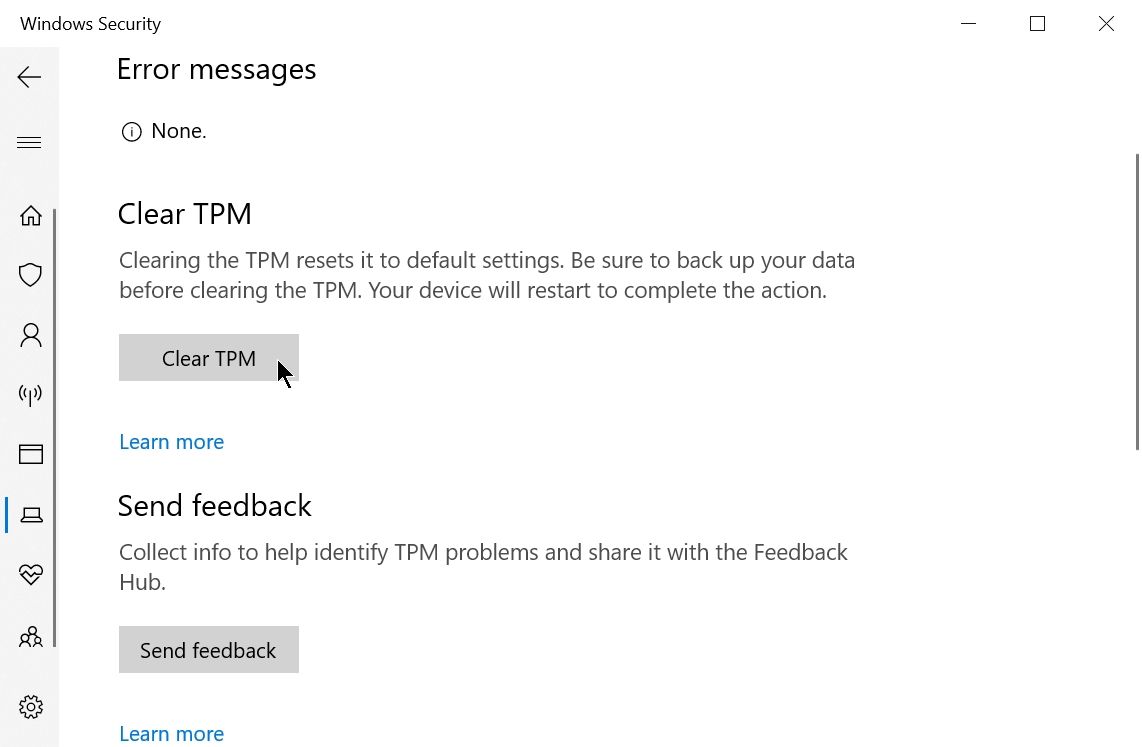
- #UNINSTALL THE TRUSTED PLATFORM MODULE DRIVER HOW TO#
- #UNINSTALL THE TRUSTED PLATFORM MODULE DRIVER INSTALL#
- #UNINSTALL THE TRUSTED PLATFORM MODULE DRIVER UPDATE#
- #UNINSTALL THE TRUSTED PLATFORM MODULE DRIVER DRIVER#
- #UNINSTALL THE TRUSTED PLATFORM MODULE DRIVER MANUAL#
#UNINSTALL THE TRUSTED PLATFORM MODULE DRIVER HOW TO#
Alternatively, take a look at how to perform a clean boot in Windows 10 to understand better how the process works. Then reverse the changes you made and use your computer as you would. If the error doesn't appear, then uninstall any recently installed third-party application. Under the Startup tab, click on each service one by one and click on Disable.
#UNINSTALL THE TRUSTED PLATFORM MODULE DRIVER UPDATE#
Or you can launch the Device Manager and select Security Devices.Then select the Trusted Platform Module and click on Update driver. For more information, visit Microsoft’s support page.
#UNINSTALL THE TRUSTED PLATFORM MODULE DRIVER INSTALL#
Now, press CTRL + Shift + Esc to launch the Task Manager. Then, install the latest TMP updates from your device manufacturer’s website. Then select all the services listed in the window, and click Disable all. A TPM chip is a secure crypto-processor that is designed to carry out cryptographic operations. Also, you have to make sure that the Secure Boot is turned on to successfully upgrade to Windows 11. Trusted Platform Module (TPM) technology is designed to provide hardware-based, security-related functions.
#UNINSTALL THE TRUSTED PLATFORM MODULE DRIVER DRIVER#
Exit the UEFI settings and restart the computer. This package provides the Broadcom Trusted Platform Module Driver and is supported on Precision M70/M20 and Latitude D410/D610/D810/X1 that are running the following Windows Operating Systems. (b) requires a special Trusted Platform Module (TPM) on the motherboard to verify on boot that the computer has not changed. Setting boot mode to UEFI is the most secure value for Boot Mode. In Windows, you use the applet to uninstall, change, or repair programs. Select the Enabled option and press Enter. System Settings Security Trusted Platform Module OneCLI: TrustedComputingGroup.DeviceOperation 'Update to TPM2.0 compliant' Set Boot Mode to UEFI Boot Mode determines which mode the system used to boot. In the next window, click on the Services tab.Ĭheck the Hide all Microsoft services box. Select the Trusted Platform Module (TPM) option and press Enter. In the search results, click on System Configuration. In the Start menu search bar, type sysconfig. 2 Look to see if the TPM Management console shows your PC having a TPM available or not. 1 Press the Win + R keys to open Run, type tpm.msc into Run, and click/tap on OK to open the TPM Management snap-in. Control Panel - Add or Remove Programs and delete the Infineon TPM Professional Package. To See if PC has a TPM and TPM Details in TPM Management snap-in console. enter C:utildriverstpminfineonsetup.exe, and click OK.
#UNINSTALL THE TRUSTED PLATFORM MODULE DRIVER MANUAL#
It's not unusual for third-party software to conflict with your Windows PC. Trusted Platform Module (TPM) We recommend that this Installation Manual be printed. The first step in resolving common Windows errors is to perform a clean boot to check whether third-party software is causing the issue. Thankfully, there are quite a few ways you can fix the TPM malfunctioning error. Sometimes, the TPM may malfunction, resulting in users not being able to access applications such as Outlook or Microsoft Office. Operating System: Microsoft Windows 10 (64-bit) Trusted Platform Module 2.0 shows this exclaimation mark inside a triangle under Security devices in the Device Manager. I've had my machine about a year, windows 10, surface pro 4 and this has just started happening.Īny suggestions on what's gone wrong and how to fix? I use the laptop for work and pleasure so its affecting daily usability.A Trusted Platform Module (TPM) is a hardware-based security measure used to authenticate your PC. I've no idea how they are linked but it seems i can no longer get the face recognition and pin set up to function as before, i end up having to us a password only. TPM 2.0 is used in Windows 11 for a number of features, including Windows Hello for identity protection and BitLocker for data. TPM 2.0 is required to run Windows 11, as an important building block for security-related features. Try uninstall reinstall? I also can't turn this on when i start up in the settings mode by pressing and holding the power button and up-volume arrow. Most PCs that have shipped in the last 5 years are capable of running Trusted Platform Module version 2.0 (TPM 2.0).

I googled about some potentially issues and noticed in device manager i have an error 10 code for Trusted Platform Module (TPM) which may be related. Step 2: Expand the Security devices item, right-click Trusted Platform Module 2.0 and choose Uninstall device from. I can enter the code, but it's annoying having to do this each time. I've no idea what changed but did notice the face recognition stopped working shortly before all these issues came.

Under Generic Credentials, select each Microsoft Office credential and click on the arrow. From the search results, click on Credential Manager.

In the Start menu search bar, type Credential Manager. I've started getting a screen asking me for my bitlocker recovery id every time i shut down or restart. Remove the Application's Credentials From the Credential Manager.


 0 kommentar(er)
0 kommentar(er)
